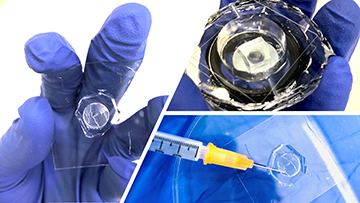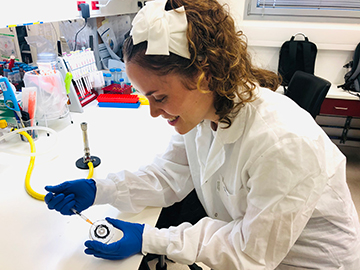
A technique for fabricating diffractive optical elements (DOEs), developed by researchers at The Technion, Israel, involves 3D-printing the element, and then tuning its optical properties by immersing it in a combination of water and glycerol within a small chamber. [Image: The Technion]
Diffractive optical elements (DOEs) shape light waves in important ways not possible with traditional refractive lenses. But usually DOEs require expensive and exacting manufacturing processes. Researchers in Israel have come up with a new recipe for creating these complex optical elements with two familiar ingredients: 3D printing and a common food additive (Nat. Commun., doi:10.1038/s41467-021-23279-6).
The new liquid-immersion technique consists of two steps. First, the desired optical element, such as a phase mask, is molded in a 3D printer. Then the element is placed in a chamber that’s then filled with a mixture of water and glycerol, with a refractive index close to that of the solid dielectric element.
The setup, the team reports, allows for fine-tuning of the system’s optical performance. It also permits the devices to be manufactured with larger features than previous DOEs—at scales of tens of microns instead of tens of nanometers.
Using 3D printing
According to Yoav Shechtman, associate professor of biomedical engineering at the Technion–Israel Institute of Technology, modern additive-manufacturing (or 3D-printing) devices made his team’s experiments possible. The popular machines “offer relatively high precision and large enough flexibility in design such that fabrication of our non-standard elements became possible quickly and efficiently,” he says.
Shechtman, his graduate student Reut Orange-Kedem and their Technion colleagues found that immersing a DOE in a liquid with a similar refractive index increases both the axial size of the solid element and the allowable fabrication error. Thus, using a less-precise 3D printer to make a mold for casting the solid element would give the resulting system similar relative phase error as in conventional lithographic methods.

Grad student and study first author Reut Orange-Kedem works on fabricating a DOE using the new technique. [Image: The Technion]
After making the 3D-printed mold, the researchers used it to cast a transparent polymer optical element with a refractive index of approximately 1.45, then bonded the element to a silica substrate. Next, they placed it in a clear chamber and, after flushing the device out with isopropanol to reduce air bubbles, filled it with a mixture of water and glycerol, a solvent often added to food as a sweetener and moistening agent. Changing the relative proportion of the two liquids allows users to tune the optical performance of the device.
Shechtman says the team’s biggest challenge “was probably to design and fabricate the chamber that contains the diffractive optical element and the liquid, and enables easy switching of the liquid.” Simple trial and error led them to the design presented in the article.
The Technion group tested its liquid-immersion-created DOE by using it to perform 3D single-molecule localization microscopy of fluorescent-labeled cells.
Should lens manufacturers worry?
Shechtman says the 3D-printed template for casting the optical element can be reused and can contain replicas of more than one design—two aspects that would help optics manufacturers interested in adopting the process. “The technique may be applicable for all transparent optical elements, but the major impact is on fabrication of non-conventional optical elements such as DOEs, or other optical elements with special geometries,” he says. “Of course, we will be happy to see this technique adopted in academia and in industry.”
The Technion scientists want to extend this technique to more complicated optical designs and to integrate the elements into biomedical imaging systems.
